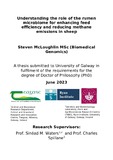| dc.description.abstract | Sheep play a vital role in global agricultural enterprises and support human
livelihoods by converting human-inedible plant matter into human-edible
products, such as meat and milk. However, the production of methane, a potent
greenhouse gas, during the fermentation of feed by sheep's rumen microbiome
contributes to anthropogenic greenhouse gas emissions. Therefore, the primary
objective of this thesis was to investigate the role of the rumen microbiome in
sheep to enhance feed utilisation, reduce methane emissions to promote the
long-term sustainability of the sector. Chapter 2 of this thesis used 16S rRNA
amplicon sequencing to investigate the bacterial and archaeal populations in
both solid and liquid fractions of the rumen of sheep with different feed
conversion rates. The study found that the rumen archaea diversity and
composition differed between feed efficient cohorts, providing evidence for the
link between methane production and dietary energy loss. Chapter 3 explored
the impact of breed on the bacterial and archaeal populations in the solid, liquid,
and epithelial rumen fractions of sheep using 16S rRNA amplicon sequencing.
The study found that breed influenced feed efficiency and the rumen bacterial
populations, with potential applications for breeding programs aimed at selecting
microbiomes that can utilise feed efficiently and produce less methane. The
study also found variations in the distribution of bacterial taxa between ruminal
fractions, revealing a rumen fraction bias that has implications for sheep rumen
sampling techniques. Chapter 4 used PACs to investigate the effect of time off
feed (TOF) on methane emissions and employed meta-omics techniques to
assess the influence of TOF on rumen bacterial and archaeal communities in
pasture-grazed sheep. The study found that TOF can influence methane
emissions and the composition of the rumen microbiome, which could have
implications for methane-microbiome studies involving animals that spend
variable amounts of time off feed. Overall, this thesis showed that the rumen
microbiome is influenced by a range of factors such as feed efficiency, breed,
ruminal fraction, and time off feed, with potential implications for improving feed
conversion efficiency, reducing methane emissions, and optimising rumen
sampling techniques. | en_IE |


